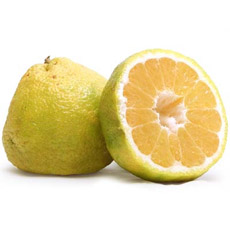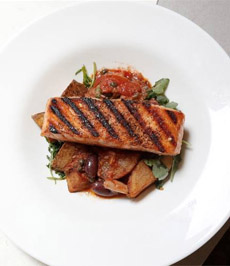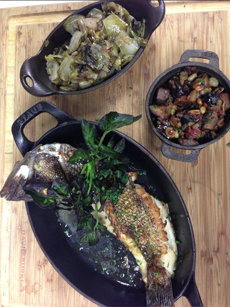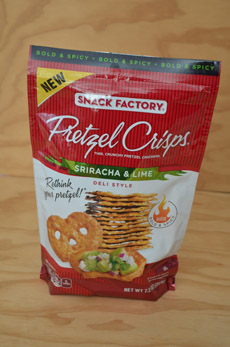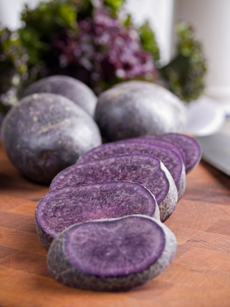|
Each year, we notice a hot new food trend. Often it’s a new flavor, blasting through everything from salad dressing to popcorn. Notable past flavor explosions like chipotle, jalapeño, and wasabi introduced new kinds of heat to the American palate. The current “it” flavor seems to be sriracha.
WHAT IS SRIRACHA?
Sriracha, pronounced see-RAH-jah, is a Thai hot chili sauce. It’s made from red chiles, distilled vinegar, garlic, sugar, and salt; and is aged for three months or longer.
Unlike American hot sauces such as Tabasco, which are vinegar sauces that are infused with hot chiles, sriracha is primarily puréed chiles, making it a much thicker sauce.
The sauce is named after the coastal city of Si Racha in eastern Thailand, where it was first made and marketed. Different brands can be found in the Asian aisle of many supermarkets and in Asian groceries.
The most popular brand is Huy Fong Sriracha Hot Chili Sauce (photo #1). It looks imported but it’s made by a California manufacturer (it was created in 1980 by Chinese-Vietnamese Californian).
It has a large rooster logo in the center of the bottle. The rooster has been knocked off by Red Rooster Louisiana Hot Sauce, a product of Louisiana-based Bruce Foods.
The Rooster’s ingredients are chiles, sugar, garlic, salt, distilled vinegar, potassium sorbate and sodium bisulfite as preservatives, and xanthan gum, a thickening agent, emulsifier, and stabilizer that prevents ingredients from separating.
THE HISTORY OF SRIRACHA SAUCE
According to multiple sources, including an article in Bon Appétit, the sauce was made more than 80 years ago in by a local woman, Thanom Chakkapak.
She initially made the condiment for her family, and then for friends, to enjoy with the local seafood (think of it as a much hotter counterpart to American cocktail sauce). The recipe was an adaptation of a classic hot Chinese red jalapeño and garlic sauce (called chiu chow sauce or chao zhou sauce).
As is a common story in the specialty food business, they encouraged her to sell it commercially—and it became the best-selling chile sauce in Thailand.
In 1984, Ms. Chakkapak sold her business to a major food company, Thai Theparos Food Products.
According to multiple sources, including an article in Bon Appétit, the sauce was made more than 80 years ago in by a local woman, Thanom Chakkapak.
She initially made the condiment for her family, and then for friends, to enjoy with the local seafood (think of it as a much hotter counterpart to American cocktail sauce).
As is a common story in the specialty food business, they encouraged her to sell it commercially—and it became the best-selling chile sauce in Thailand.
In 1984, Ms. Chakkapak sold her business to a major food company, Thai Theparos Food Products.
|
|
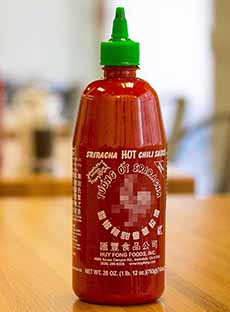
[1] Rooster, the most popular sriracha brand in the U.S., is actually made in California (photo © Steven Depolo | Wikipedia).
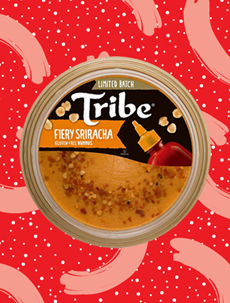
[2] Tribe adds Asian-style hot sauce to Middle Eastern hummus. Photo of new Fiery Sriracha Hummus courtesy Tribe.

[3] Americans shake sriracha on everything, from chicken and fish to eggs and pizza (photo © Huy Fong Foods)
|
What’s the correct spelling: sriraja, si-racha, sriracha, or siracha?
According to Andrea Nguyen, who wrote the article for Bon Appétit: Since Thailand does not adhere to one romanization system for Thai words, many variants have emerged, chosen by manufacturers who have created their own version of the original sauce.
However, the most commonly accepted spelling is sriracha.
NEW PRODUCT: TRIBE LIMITED EDITION FIERY SRIRACHA HUMMUS
Tribe’s latest hummus flavor, Limited Batch Fiery Sriracha, is heating up the hummus category when it hits grocery store shelves later this month.
In addition to blending sriracha sauce into the hummus, the flavor is topped with red pepper flakes for an extra splash of heat.
Is America going flavor-crazy with its hummus? According to Tribe, non-traditional hummus flavors represented nearly half of the total hummus sales in 2014! Discover more at TribeHummus.com.
|


